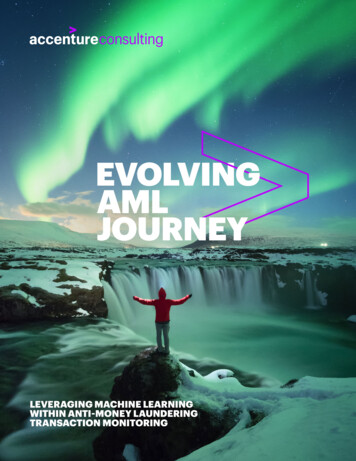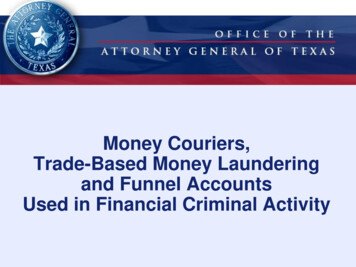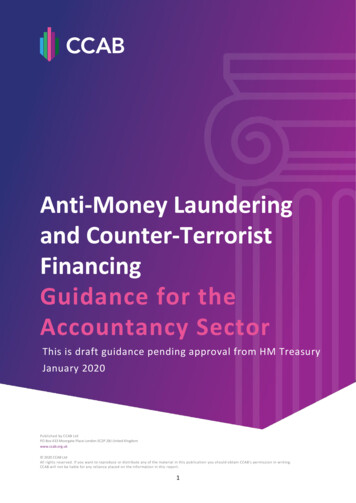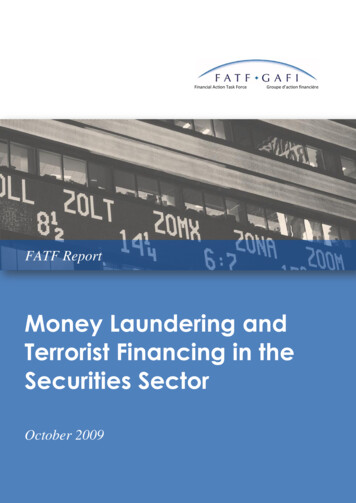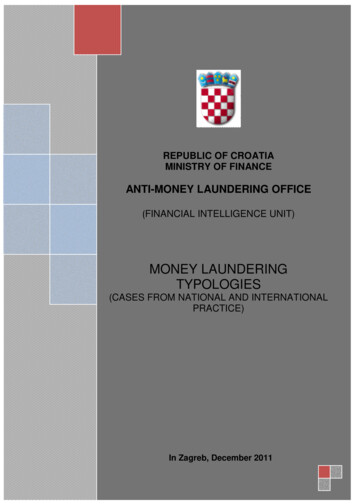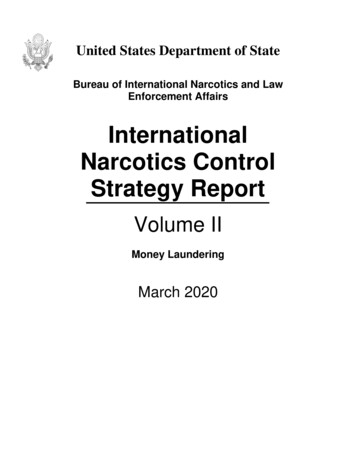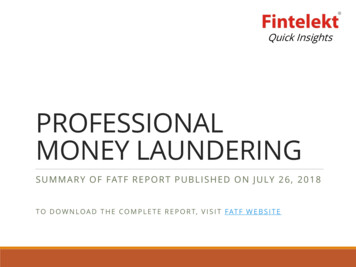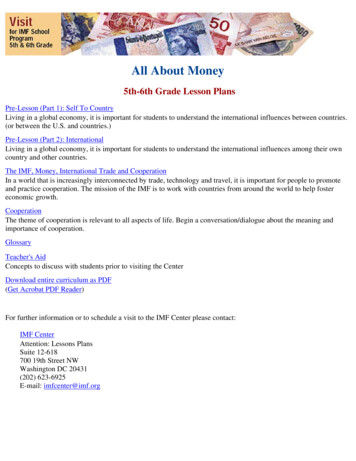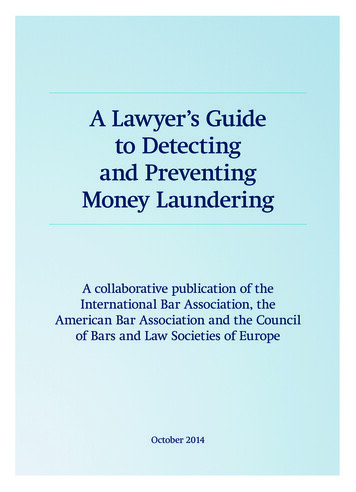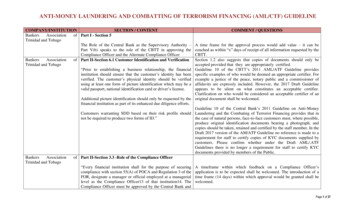
Transcription
ANTI-MONEY LAUNDERING AND COMBATTING OF TERRORISM FINANCING (AML/CTF) GUIDELINECOMPANY/INSTITUTIONSECTION / CONTENTBankersAssociationof Part I - Section 5Trinidad and TobagoThe Role of the Central Bank as the Supervisory Authority –Part V(b) speaks to the role of the CBTT in approving theCompliance Officer and the Alternate Compliance OfficerBankersAssociationof Part II-Section 6.1 Customer Identification and VerificationTrinidad and Tobago“Prior to establishing a business relationship, the financialinstitution should ensure that the customer’s identity has beenverified. The customer’s physical identity should be verifiedusing at least one form of picture identification which may be avalid passport, national identification card or driver’s license.BankersAssociationTrinidad and TobagoCOMMENT / QUESTIONSA time frame for the approval process would add value – it can becouched as within “x” days of receipt of all information requested by theCBTT.Section 1.2 also suggests that copies of documents should only beaccepted provided that they are appropriately certified.Guideline 10 of the CBTT’s 2011 AML/ATF Guideline providesspecific examples of who would be deemed an appropriate certifier. Forexample a justice of the peace, notary public and a commissioner ofaffidavits are expressly included. However, the 2017 Draft Guidelineappears to be silent on what constitutes an acceptable certifier.Clarification on who would be considered an acceptable certifier of anAdditional picture identification should only be requested by the original document shall be welcomed.financial institution as part of its enhanced due diligence efforts.Guideline 10 of the Central Bank’s 2011 Guideline on Anti-MoneyCustomers warranting SDD based on their risk profile should Laundering and the Combating of Terrorist Financing provides that innot be required to produce two forms of ID.”the case of natural persons, face-to-face customers must, where possible,produce original identification documents bearing a photograph, andcopies should be taken, retained and certified by the staff member. In theDraft 2017 version of the AM/ATF Guideline no reference is made to arequirement for staff to certify copies of KYC documents supplied bycustomers. Please confirm whether under the Draft AML/.ATFGuidelines there is no longer a requirement for staff to certify KYCdocuments provided by members of the Public.of Part II-Section 3.3 -Role of the Compliance Officer“Every financial institution shall for the purpose of securingcompliance with section 55(A) of POCA and Regulation 3 of theFOR, designate a manager or official employed at a manageriallevel as the Compliance Officer13 of that institution14. TheCompliance Officer must be approved by the Central Bank andA timeframe within which feedback on a Compliance Officer’sapplication is to be expected shall be welcomed. The introduction of atime frame (14 days) within which approval would be granted shall bewelcomed.Page 1 of 37
ANTI-MONEY LAUNDERING AND COMBATTING OF TERRORISM FINANCING (AML/CTF) GUIDELINECOMPANY/INSTITUTIONSECTION / CONTENTmust therefore satisfy the definition of an “officer” as containedin the respective legislation15 that governs financial institutionsand satisfy the “fit and proper” requirements outlined in theCentral Bank’s Fit and Proper Guideline . “COMMENT / QUESTIONS“ Where a financial institution is also registered with theTTSEC, the financial institution must submit applications for theapproval of a Compliance Officer simultaneously to eachSupervisory Authority (SA). The application to each SA shouldindicate that an application was also submitted to the other SA.Where a financial institution has five or fewer employees, asmay be the case with an insurance broker, bureau de change ormoney remittance business, the most senior employee shall bethe Compliance Officer.”In a situation where a Financial Institution is governed by two (2)Supervisory Authorities who may have different views on the suitabilityof an applicant, guidance is required on what recourse a FinancialInstitution has as this can result in significant delays in the approvalprocess. For example where an applicant is approved by the CBTT to bedesignated Compliance Officer but not approved by another SupervisoryAuthority, can that person still exercise the functions of a ComplianceOfficer? It is submitted that some degree of collaboration betweenSupervisory Authorities is necessary when assessing applications for theapproval of Compliance Officers and Alternate Compliance Officers.We seek clarification regarding the type of supporting documentsneeded to accompany the request for approval of the Compliance Officerby the CBTT. The Guidelines should expressly provide for this.Role of the Compliance Officer – Part A of the second Whereas the regulation 3(3) of the Financial Obligations Regulationsparagraph speaks to the reporting line for the Compliance and section 2.3 of the Draft Guidelines prescribe that for FIs with fewerOfficerthan 5 employees the most senior employee must be designated theCompliance Officer, this requirement can become financiallyburdensome to smaller FI's.We recommend that consideration be given to an amendment to theFOR and Draft AML/ATF Guidelines to increase the number ofemployees to 20.The very first line should read the Compliance Officer “and thePage 2 of 37
ANTI-MONEY LAUNDERING AND COMBATTING OF TERRORISM FINANCING (AML/CTF) GUIDELINECOMPANY/INSTITUTIONSECTION / CONTENTCOMMENT / QUESTIONSAlternate Compliance Officer”.Part (a) noted that the Compliance Officer should have a “directreporting line to Senior Management and where necessary to the Boardof Directors.” Please clarify as it is understood that the requirement isthat the Compliance Officer must have direct access to the Board or adesignated Committee of the Board in order to ensure independentaccess.BankersAssociationTrinidad and Tobagoof Part II-Section 3.3 -Role of the Alternate Compliance Officer It is noted that the section provides that the ACO must be a senioremployee and the Compliance Officer must satisfy the definition ofFinancial institutions are required to appoint a senior employee “Officer” as outlined in the Financial Institutions Act. Clarification isas an alternate to the Compliance Officer (ACO) in accordance required on whether the ACO would also be required to satisfy thewith Regulation 3(8) of the FOR who would have the same definition of an “Officer” under the Financial Institutions Act or if thatresponsibilities of the Compliance Officer (in his absence). In person can be a senior team member and not necessarily employed atthe performance of his duties, the ACO should have regard for management level.and effectively perform all the duties of the Compliance Officeras outlined in the FOR and this Guideline. Consequently, all Further, re an ACO, similar to a CO, the expectation from the CBTTrequirements and responsibilities stipulated for the Compliance appears to be an assessment of whether the person is a “seniorOfficer under this part also apply to the Alternate Compliance employee”- the person should have sufficient authority and autonomy toOfficer.implement and enforce AML/CTF policies, procedures and measures atthe institution; whether the person is sufficiently trained to carry out thecompliance function at the institution / has knowledge of therequirements of local laws, regulations and guidelines which governAML/CFT; independence - potential conflicts of interest that may arisebetween the compliance responsibilities of the CO/ACO and any otherresponsibilities that the person may have at the institution would beconsidered. For smaller organizations of even 50 or more staff, meetingall of these criteria may not be possible, therefore leading to a potentialbreach of the requirement of having an ACO. Consequently, there maybe instances where a waiver of any of the 3 said criteria above may bepossible e.g. where there is a centralized compliance unit where thePage 3 of 37
ANTI-MONEY LAUNDERING AND COMBATTING OF TERRORISM FINANCING (AML/CTF) idad and TobagoSECTION / CONTENTof Part II- section 5.3 Identifying and Understanding ML/TFRisksIn order to develop a risk based AML/CFT complianceprogramme, a financial institution must first conduct a riskassessment to understand its risks. Risk assessments should helpfinancial institutions understand the inherent ML/TF riskexposure and which areas of their business they should prioritisein the fight against ML/TF. The risk assessment should beapproved by the Board and form the basis for the developmentof policies and procedures to mitigate ML/TF risks. It shouldreflect the risk appetite of the institution and establish the risklevel deemed acceptable. During an examination, the CentralBank will request and evaluate the adequacy of the financialinstitution’s risk assessment.BankersAssociationTrinidad and TobagoCOMMENT / QUESTIONSpotential alternate may not meet all criteria but has the sufficient supportof an individual in the centralized compliance team who meets thecriteria. The CBTT should consider where such appropriate waiver ofthe criteria may be given and what measures would need to be in placeto compensate in order to achieve acceptable compliance with therequirement for an ACO.While the Draft Guideline states that a financial institution must conducta risk assessment to understand its risk, it appears to be silent on howfrequently a risk assessment must be conducted. Guidance on thefrequency of the risk assessment to be conducted shall be welcomed.Financial institutions are also required to incorporate the resultsof the National Risk Assessment (NRA) into their ML/TF riskassessment process and apply the appropriate simplified orenhanced measures commensurate with the identified risks.Guidance on conducting risk assessments is provided in Part IIof this Guideline.of Part II Section 5.2 AML/CFT Compliance Programmes of The Financial Obligations Regulations speaks to each entity having adesignated compliance officer and that the officer must be an employeeFinancial Groupsof that entity.Financial groups should appoint a group compliance officer withPage 4 of 37
ANTI-MONEY LAUNDERING AND COMBATTING OF TERRORISM FINANCING (AML/CTF) GUIDELINECOMPANY/INSTITUTIONSECTION / CONTENTresponsibility for the group wide AML/CFT programme and toensure its effective implementation. The group complianceofficer should have the ability to monitor and evaluate theML/TF risk posed by a particular customer or category ofcustomers to the group. Policies and procedures should includemanagement of group relationships that have been deemed highrisk, including procedures for escalation and restrictions and/ortermination of accounts or relationships.COMMENT / QUESTIONSAt first blush it would appear that the appointment of a GroupCompliance Officer as contemplated under section 4.2 is not supportedin law and will not give FIs the flexibility to appoint a GroupCompliance Officer.Certain amendment would need to be made to the legislation (POCAand FOR) to facilitate the appointment of a Group Compliance Officer.Clarification on the application of group compliance officer role asoutlined under section 4.2 in light of certain restrictions contained in theThe group compliance officer should report to the parent FOR shall be welcomed.financial institution’s Board on the adequacy of the enterprisewide programme; concerns with and recommendations for high This seems quite vague. Is this intended to reference the Compliancerisk relationships; any issues and material changes with remedial Officer designation? If so can the section be specific for avoidance ofactions and milestones; adequacy of resources supporting the doubt?programme; and make recommendations regarding the overallstructure of the programme as necessary. The group complianceofficer should also provide feedback to the compliance officersof the individual financial entities in the group on observedemerging typologies, trends and risk across the group.BankersAssociationTrinidad and TobagoRisk Based AML/CFT Compliance Programmes (page 15) –Part (d) of the last paragraph in this section requires the“designation of an individual responsible for managingAML/CFT Compliance”of Part II-7.1-Politically Exposed PersonsIt is not expected that financial institutions will automaticallytreat domestic PEPs and PEPs associated with an internationalorganization as high risk. Once the PEP status has beenestablished, the financial institution must assess the customer todetermine whether the relationship poses a high ML/TF risk andcategorize the relationship and conduct due diligenceaccordingly. Risk factors which may be considered include theTo the extent that these provisions qualify the application of enhanceddue diligence measures to domestic PEPs only where higher risks areidentified, this runs counter to certain financial institutions internalPolicies which prescribe that all confirmed PEPs are consideredautomatic High-Risk and are therefore subject to enhanced monitoring.Given the higher money laundering risks that domestic PEPstraditionally pose, it should be left up to Financial Institutions to make adetermination of enhanced due diligence measures to be applied to thesePage 5 of 37
ANTI-MONEY LAUNDERING AND COMBATTING OF TERRORISM FINANCING (AML/CTF) GUIDELINECOMPANY/INSTITUTIONSECTION / CONTENTpolitical environment and the vulnerability of the PEP’s countryto corruption, the rationale for wishing to open an account in ajurisdiction other than where political office is held and theproducts or services sought by the PEP ”COMMENT / QUESTIONScustomers. We respectfully request that consideration be given toamending the section to make it clearer that allowances will be made forfinancial institutions whose internal policies and procedures provide forthe automatic risk rating of Domestic PEPs as higher risk.Part IV -4.1 Politically Exposed Persons4.1 Some examples of a close associate may include a personwho is inter alia:“in a romantic relationship with a PEP, such as a boyfriend,girlfriend or mistress;”It is also noted that section 4.1 of the Guideline states that a closeassociate can include someone in a romantic relationship with a PEP. Itis submitted that identifying such persons could be challenging forFinancial Institutions since the number of persons who qualify asboyfriends and girlfriends of a PEPs is fluid, and may changesignificantly over time. Given the uncertainty and nebulous nature of a“romantic relationship”, we recommend that strong consideration begiven to amending the example of a close associate to a person in aknown romantic relationship with a PEP.Clarification is required on whether the intention of the section andsimilar provisions throughout the Draft Guidelines, is to requireFinancial Institutions to reach out for updated identification fromcustomers when same becomes expired. The requirement to maintaincurrent customer identification documents has been particularlychallenging for most Banks. It is impractical to comply with particularlywhere a financial institution has thousands of customers in its database.Significant time and resources is required to track expired IDs whichwould have been valid at the material time that they were on boarded.The associated cost with implementing technology to track IDs of acustomer data base can be prohibitive, particularly for smaller financialinstitutions.Strong consideration should be given to addressing the following riskbased approach to updating CDD:(a)for higher risk categories of customers, a bank should obtainupdated CDD information (including updated copies of the customer’spassport or identity documents if these have expired), as part of itsperiodic CDD review, or upon the occurrence of a trigger event as““BankersAssociationTrinidad and Tobagoof Part I- 8.4 Ongoing Monitoring and ReviewIn addition to keeping risk assessments up to date and relevant,financial institutions must monitor transactions to ensure thatthese are in line with the customer’s risk profile and businessand where necessary, examine the source of funds to detectpossible ML/ TF. Documents, data or information must be keptup to date on a risk-sensitive basis, with a view to understandingwhether the risk associated with the business relationship haschanged.Page 6 of 37
ANTI-MONEY LAUNDERING AND COMBATTING OF TERRORISM FINANCING (AML/CTF) idad and TobagoBankersAssociationTrinidad and TobagoBankersAssociationTrinidad and TobagoBankersAssociationTrinidad and TobagoSECTION / CONTENTCOMMENT / QUESTIONSdeemed necessary by the bank, whichever is earlier; and (b) for all otherrisk categories of existing customers, a bank should obtain updated CDDinformation upon the occurrence of a trigger event.Trigger events can include a significant transaction taking place, amaterial change occurring in the way the customer’s account is operated,change in management or authorized signers or where the bank becomesaware that it lacks sufficient information about the customer concerned.of Part II Section 6.1The section seems quite prescriptive, and the preference would be thatthe minimum standard be set (1 form of ID) and Banks should beallowed to manage outside of that requirement based on their riskCustomer Identification and VerificationThe fourth paragraph down gets into the ID requirements for profiles and internal policies.customersof Part II Section 6.3While this and the entire tone of the customer due diligence sections iswelcomed, the legislative changes to support the same are necessary, asLower Risk/Simplified Due DiligenceBanks will run into issues with both local auditors and correspondentbanks who may do on sites. The CBTT Guideline as presented allowsfor deferrals in terms of the timing and receipt of documents, andsuggests that some requirements are “nice to have” as opposed tomandatory (this is applicable throughout the Guidelines so we have notidentified each specific one). This does not align with the currentFinancial Obligations Regulations, and timely amendments to thatpiece of legislation are welcomed.of Part II Section 6.4The second paragraph notes that the “commencement of a businessrelationship with a high risk customer must be approved by seniormanagement”. This seems quite onerous, particularly depending on theHigher Risk/Enhanced Due Diligenceway that different Banks define “senior management”. The preferencewould be to ask that a process for escalated approval of high riskaccounts be included in the Banks’ respective risk frameworks.of Part II Section 7.1.1Politically Exposed Persons Time Limits on PEPsWe welcome the ability to de-classify PEPs depending on passage oftime and actual influence following their departure from public life –Page 7 of 37
ANTI-MONEY LAUNDERING AND COMBATTING OF TERRORISM FINANCING (AML/CTF) GUIDELINECOMPANY/INSTITUTIONSECTION / CONTENTPart II 7.2 Non Face-to-Face Business“It is important to note that not all non-face-to-face businessrelationships will present higher risk. Examples of potentiallyhigher risk situations include where there is no direct face-toface communication with the customer such as during theaccount opening process or where products or services facilitateanonymity.Examples include conducting transfers according to instructionsconveyed by customers over the internet, post, fax or telephone.Non face-to-face applications and transfers undertaken acrossthe internet pose greater risks than other non-face-to-facebusiness due to the following factors which collectivelyaggravate the ML/TF risks: The ease of unauthorized access to the facility, across timezones and location;The ease of making multiple fictitious applicationswithout incurring extra cost or the risk of detection;Absence of physical documents; andThe speed of electronic transfers.The measures taken for verification of a customer’s identityin respect of non-face-to-face business relations with ortransfers for the customer will depend on the nature andcharacteristics of the product or service provided and thecustomer’s risk profile .”COMMENT / QUESTIONScan a minimum “cooling off” period be set though for someconsistency?Certain Postal, Telephonic and Electronic Business With a view topromoting the ease of doing business it is respectfully recommended thatsimilar to territories such as Antigua, St. Kitts and St. Lucia theconsideration be given to amending the section to expressly provide thatwhere an applicant for business pays or intends to pay monies to afinancial institution by post, or electronically, or bytelephoned instruction, in respect of a non-paying account and: it is reasonable in all the circumstances for payment to be made bysuch means; and such payment is made from an account held in the name of theapplicant for business at another local regulated business, orrecognized foreign regulated business; and the name(s) of theapplicant for business corresponds with the name(s) of the payingaccount-holder; and the receiving financial institution keeps a record of the applicant’saccount details with that other regulated business; and there is no suspicion of money laundering or terrorist financing, Thefinancial institution is entitled to rely on verification of the applicant for business by that other regulated business to the extent that it isreasonable to assume that verification has been carried out andcompleted.The expression “non-paying account” above is used to mean an account,investment or other financial services product which does not provide: cheque or other money transmission facilities, or the facility for transfer of funds to other types of products which doprovide such facilities, or The facility for repayment or transfer to a person other than theapplicant for business whether on closure or maturity of the account,Page 8 of 37
ANTI-MONEY LAUNDERING AND COMBATTING OF TERRORISM FINANCING (AML/CTF) GUIDELINECOMPANY/INSTITUTIONSECTION / CONTENTCOMMENT / QUESTIONSor on realization or maturity of the investment or other financialservices product or otherwise.BankersAssociationTrinidad and Tobagoof Part II Section 7.5Technological DevelopmentsOn a general note, given the advent of BITT coin, e money and theseother fast evolving technologies, some specific guidance is welcomedfrom the CBTT regarding both partnering with and banking these typesof business – particularly with regard to CDD, non-face to face accountopening, electronic signatures etc. A wider discussion may be neededhere.BankersAssociationTrinidad and Tobagoof Part II Section 8.1The law specifies 14 days of a transaction being deemed suspicious byReporting Suspicious Activity and Transactions “Promptly” to the Compliance Officer (not transaction). The introduction ofthe FIU“promptly” further muddles an already grey timeframe. Some furtherreview of how to measure the timeliness of filings given the realities ofthe investigative process are welcomed.BankersAssociationTrinidad and Tobagoof Part II- Section 9. Identification Of Designated Entities And We welcome clarification on the Senior Management to whom positivematches resulting from Sanctions screening must be reported to underPersons & Freezing Of Fundsthis section. Is it the Compliance Officer?Financial institution’s policies and procedures should address :“The steps to be taken by the financial institution for reportingpositive matches to senior management and the FIU”BankersAssociationTrinidad and Tobagoof Part IV-1.2 Documentary Verification ProceduresPart II Section 6.1 asserts that a customer’s identity must be verifiedusing at least 1 piece of picture Identification and that additional picture“1.2 Even though not required or necessary in all circumstances, identification should only be requested by the financial institution as partgiven the availability of counterfeit and fraudulently obtained of its enhanced due diligence efforts.documents, financial institutions should review more than asingle document to ensure that it has a reasonable belief that it However, Part IV section 1.2 states that Financial Institution shouldknows the customer’s true identity.review more than a single document to ensure that it knows thecustomer’s true identity. Clarification is required on the expectation ofIn addition, where original documents are not available, the the CBTT as it relates on the collection of identification by FinancialPage 9 of 37
ANTI-MONEY LAUNDERING AND COMBATTING OF TERRORISM FINANCING (AML/CTF) GUIDELINECOMPANY/INSTITUTIONSECTION / CONTENTCOMMENT / QUESTIONSfinancial institution should only accept copies of documents that Institutions as there appears to be some contraction between sections 5.1have been appropriately certified”and 1.2.BankersAssociationTrinidad and Tobagoof Part IV-1.4 Identification and Verification of Identity of There is an opportunity for greater clarification on the application of thissection. Does this requirement apply to a company and/or individualPersons Appointed to Act on a customer's behalfcustomers?“Where there are several persons appointed to act on behalf ofmore than 10 authorised signatories), the financial institutionshould verify at a minimum those natural persons who will bedealing directly with the financial institution”BankersAssociationTrinidad and Tobagoof Part IV 4.4 Introduced BusinessBankersAssociationTrinidad and TobagoThe requirement contained in sub-paragraph 4.4 for a written agreementdocumenting the responsibilities of the Financial Institution and theA financial institution may rely on other regulated third parties Introducer is duly noted.to introduce new business in whole or in part. Nevertheless, theultimate responsibility remains with the financial institution forWe require clarification on whether the said agreement between thecustomer identification and verification that the documentary parties is the same or additional to the Regulation 14(1) (a) FORevidence of the introducer that is being relied upon, is requirement for a written assurance from the introducer that the identitysatisfactory for these purposes.of the customer has been verified.Financial institutions should therefore: Document in a written agreement theresponsibilities of the two parties; of Part IV – Section 4.1 Politically Exposed PersonsrespectiveThe wording of the first paragraph needs to be re-looked. The sectionnotes that the “definition of PEP is not intended to cover middle rakingor junior individuals” – this is acceptable – but then it goes on to read“in the following categories” and proceeds to list several categories ofpersons who really cannot be construed as middle ranking or junior.The second paragraph identified some examples of close associates of aPEP and includes “a person who is in a romantic relationship with aPage 10 of 37
ANTI-MONEY LAUNDERING AND COMBATTING OF TERRORISM FINANCING (AML/CTF) idad and TobagoBankersAssociationTrinidad and TobagoSECTION / CONTENTCOMMENT / QUESTIONSPEP, such as a boyfriend, girlfriend or mistress.” This may be a stretch,and inappropriate for a Bank to make a concrete determination on, andcould lead to issues in front line team member dealings with suchpersons if EDD is requested and enquiries are made as to why. Someguidance and clarity is needed. The second to last bullet in this sectionnotes close associates of PEPs include “a person who is serving on amember of the same Board as a PEP”. Especially given that closeassociates of PEPs are deemed PEPs, this seems quite far reaching.of Part II Section 4.1.4The first paragraph notes “a PEP may pose a lower risk if he/she solelyoperates in a country such as the UK that has the followingExamples of Risk Indicators for PEPs Lower Risk Indicators for characteristics ” Recommend that the words “such as the UK” bePEPsremoved. There are some bulleting errors (typos) from page 15 into 16 –to be amended.of National Risk AssessmentFinancial institutions are also required to incorporate the resultsof the National Risk Assessment (NRA) into their ML/TF riskassessment process and apply the appropriate simplified orenhanced measures commensurate with the identified risks.BankersAssociationTrinidad and Tobagoof Other General Observations/CommentsGrace period for AuditorsThe CBTT and other relevant key stakeholders involved in the processof doing and publishing the NRA, are encouraged to ensure that theNRA is published and commensurately current to be relevant. TheGuidelines should state how often the NRA will be done and available toFIs therefore.Given the focus of RBA in the Guidelines, this will impact the externalauditors’ annual audit review of FI’s. It is noted in this regard that whilethe CBTT will meet with ICATT to discuss such audit changes , thatthere be a grace period of perhaps a year for measures in the guidelinesto be considered and met by the FI’s and the auditors alike. Auditorsshould also in this vein be encouraged to seek the FI’s basis for theirprocesses and procedures rather than seeking a one size fits all (with theRBA does not support).1. The requirement to secure a reference from a foreign bank forforeign customers under regulation 15(3) of the FinancialObligations Regulations is not always practical to achieve as somePage 11 of 37
ANTI-MONEY LAUNDERING AND COMBATTING OF TERRORISM FINANCING (AML/CTF) GUIDELINECOMPANY/INSTITUTIONSECTION / CONTENTForeign ad and Tobagoof Sensitization of Broader Industry StandardsCOMMENT / QUESTIONSforeign banks have a policy of not providing such references to thirdparty institutions. We respectfully recommend that the DraftGuideline make express provision for flexibility and a risk basedapproach to be applied whereby Financial Institutions can adoptalternative methods of enhanc
anti-money laundering and combatting of terrorism financing (aml/ctf) guideline page of 37 company/institution section / content comment / questions
